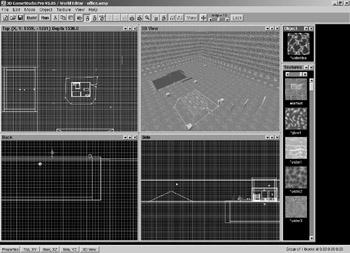Other Choices
While the previously mentioned programming languages seem to offer the most, there are a few additional choices when it comes to game programming. They range from programs very similar to Visual Basic to others that are designed specifically for game programming.
Delphi
Delphi is very similar to Visual Basic in that its ease of use and IDE are its most important features. Like VB, Delphi has had tremendous support from the large user base, including complete 3D engines and third-party controls for accessing DirectX. We’ll not get into the VB versus Delphi argument in this book because it is very heated, with programmers from both sides of the fence defending their favorite environment.
Delphi has been a Windows-only product, although a recently released program called Kylix is essentially Delphi for Linux. This could be a big plus for those out there looking for an easy way to develop applications for Linux. There are several books available for Delphi as it relates to game programming, along with several user groups and message boards on the Internet.
Java
Java is a portable language developed by Sun to compete with C++. It has borrowed many aspects of the C++ language, although it seems to be a little easier for beginning programmers to learn. The programs you develop can be platform independent, and most can run embedded in Web pages. The language became popular seemingly overnight, with thousands of developers rushing to learn the new offering. There are thousands of Web sites, newsgroups, and message boards for Java programmers. Add to this the large numbers of books and learning resources, and you have a relatively easy to learn language with a tremendous number of resources.
Similar to Visual Basic, Java uses a runtime engine called a virtual machine to execute Java programs. This makes applications slower than truly compiled programs, but new technologies like just-in-time compilers have greatly enhanced the speed at which Java programs execute. It is very portable, but user interface elements often have to be rewritten to work on different platforms. There are not many commercial games written in Java, but this will probably change in the future as many developers become better acquainted with the language and speed improvements continue to unfold.
Macromedia Director
Authoring tools such as Macromedia Director have long been used for the development of games. Many current and past commercial games have been developed using these types of programs. Director, which is arguably the leading development tool in this area, has several strong features that make it a possibility for the right type of game project. First, it is cross-platform capable, which is a big factor for certain projects. There are also many Xtras (a term for Director add-in controls) available that increase the productivity of Director applications.
The newest release of Director (version MX 2004 at the time of writing) continues to enhance this already popular program. It includes a complete 3D engine courtesy of Intel’s Internet 3D graphics software, which offers adaptive geometry and rendering. The algorithms of the software rendering engine enable 3D content to scale to the user’s machine. It includes support for DirectX and OpenGL hardware acceleration. Of particular interest to game developers is a third-party Xtra that will enhance the capabilities of the 3D engine with the addition of Havok’s real-time interactive physics.
Director uses a language called Lingo to add custom programming to a project. Because of the popularity it has managed to gain throughout the years, there are many third-party books and training resources for Director, making it a possibility for certain types of projects.
3D Game Studio
Another authoring system, 3D Game Studio, offers the capability to create 2D and 3D computer games. As its name implies, it was designed first and foremost as a game development environment, a point that is very important because it has been optimized for the development of games. It includes several modeling and level-building tools, which can be seen in Figure 6.3. 3D Game Studio uses a JavaScript-style programming language with an integrated 3D engine and a 2D engine. It also includes a Visual C++ interface, along with a map and model editor. 3D Game Studio has a nice mix of features if you are a beginner or an experienced game programmer.

Figure 6.3: The level editor that ships with 3D Game Studio.
3D RAD
3D RAD is perhaps the easiest to use authoring tool of any mentioned here, although it is probably not the best choice for commercial-quality games. It offers several interesting features, including prebuilt objects that can be used in a program without the need to alter them. For example, you can place one of the 3D car models into a scene, and the model will already have basic movement capabilities and collision information. Unfortunately, the models are very generic, and the movements are really too simple for a commercial game; in addition, the 3D rendering needs some speed and quality improvements. This is a program that is best suited for a beginner, and if a few items are changed, it could offer a complete solution for 3D games.
EAN: 2147483647
Pages: 168